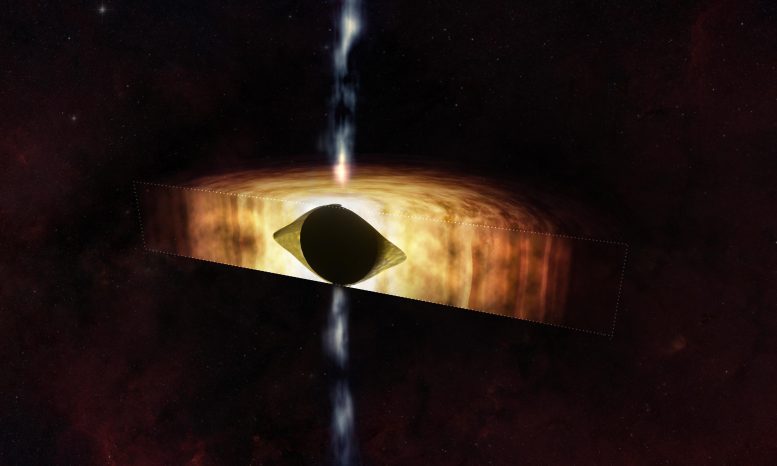Traveling at Warp Speed: The Spacetime Distortions caused by Our Galaxy's Black Hole

Shown in a cross-section artist's illustration, there is a supermassive black hole and surrounding material at the very heart of our galaxy. The black sphere in the center is the black hole's event horizon, the threshold at which nothing, including light, can escape. The illustration portrays a side view of the spinning black hole, showing surrounding spacetime that is strikingly similar to the shape of an American football. The bright, yellow-orange material on either side symbolizes gas caught in a whirl around the black hole. As the material approaches the black hole, it falls within the football shape and crosses the event horizon. Consequently, the area within this shape but external to the event horizon looks cavitated. There are blue blobs that depict jets shooting away from the black hole's spinning poles. Credit: NASA/CXC/M.Weiss
The supermassive black hole at the heart of our Milky Way galaxy, known as Sagittarius A*, is spinning so rapidly that it distorts the spacetime around it. This warp has an impact on galactic dynamics and can potentially affect the birth of future stars.
A recent study utilizing data from NASA's Chandra X-ray Observatory and the National Science Foundation's Karl G. Jansky Very Large Array (VLA) surmises that the black hole at the center of the Milky Way is spinning at such a high velocity that it is molding surrounding spacetime into a football-like shape.
This massive black hole, known as Sagittarius A* (or Sgr A* for short), lies approximately 26,000 light-years away from Earth in our galaxy's center.
Two fundamental properties of black holes, their mass (weight) and spin (rotation speed), offer crucial insights into their behavior and functions, when known.
Using a novel methodology that utilizes X-ray and radio data, a research team was able to determine the spin rate of Sgr A*, in relation to how material flows towards and away from the black hole. The researchers discovered that Sgr A* has an angular velocity (revolutions per second) that is near 60% of the maximum possible value, a threshold determined by the inability of material to move faster than light.
Past estimates of Sgr A*'s spin rate have varied significantly, with some studies suggesting no rotation at all while others propose a near-maximum spin rate.
Ruth Daly of Penn State University, the leading author of the new study, affirms, “Our research may help resolve the debate over the spin speed of our galaxy’s supermassive black hole. Our findings suggest that Sgr A* is spinning incredibly fast, which is not only intriguing but holds far-reaching implications.”
Depicted is a Chandra X-ray image of Sagittarius A* and the area surrounding it. Credit: NASA/CXC/Univ. of Wisconsin/Y.Bai, et al.
A spinning black hole creates a pull effect on “spacetime” (the combination of time and three spatial dimensions) and surrounding matter. The spacetime around a spinning black hole compresses, assuming a circular shape when viewed from above. From a sideways perspective, the spacetime looks more like a football, with increasing rotation flattening the shape further.
A black hole’s spin serves as a key energy source, generating focused outflows such as jets when spin energy is harnessed, but only if the black hole is situated near some quantity of matter. Owing to the limited fuel in proximity, Sgr A* has been relatively dormant in recent millennia, emitting rather weak jets. However, the new findings show that an increase in nearby matter could potentially activate it.
Co-author Biny Sebastian of the University of Manitoba in Winnipeg, Canada, equates a spinning black hole to a "rocket on the launch pad". As soon as material draws near, the "launch" button is effectively pushed.
Should the properties of nearby matter and the strength of the magnetic field change in the future, the enormous energy from the black hole's spin could power more potent outflows. The required source material might be sourced from gas or the remnants of a star, if it strays too close to Sgr A* and is torn apart by the black hole's gravitational pull.
“Jets powered and collimated by a galaxy’s spinning central black hole can profoundly affect the gas supply for an entire galaxy, which affects how quickly and even whether stars can form,” said co-author Megan Donahue from Michigan State University. “The ‘Fermi bubbles’ seen in X-rays and gamma rays around our Milky Way’s black hole show the black hole was probably active in the past. Measuring the spin of our black hole is an important test of this scenario.”
To determine the spin of Sgr A*, the authors used an empirically based theoretical method referred to as the “outflow method” that details the relationship between the spin of the black hole and its mass, the properties of the matter near the black hole, and the outflow properties. The collimated outflow produces the radio waves, while the disk of gas surrounding the black hole is responsible for the X-ray emission. Using this method, the researchers combined data from Chandra and the VLA with an independent estimate of the black hole’s mass from other telescopes to constrain the black hole’s spin.
“We have a special view of Sgr A* because it is the nearest supermassive black hole to us,” said co-author Anan Lu from McGill University in Montreal, Canada. “Although it’s quiet right now, our work shows that in the future it will give an incredibly powerful kick to surrounding matter. That might happen in a thousand or a million years, or it could happen in our lifetimes.”
The supermassive black hole in the center of the Milky Way is spinning so quickly that it is warping the spacetime surrounding it into a shape that can look like an American football. This result was made using data from NASA’s Chandra X-ray Observatory, an X-ray telescope in space, and the NSF’s Very Large Array, an array of radio telescopes in New Mexico. Credit: NASA/CXC/A. Hobart
The paper describing these results led by Ruth Daly is published in the January 2024 issue of the Monthly Notices of the Royal Astronomical Society.
Reference: “New black hole spin values for Sagittarius A* obtained with the outflow method” by Ruth A Daly, Megan Donahue, Christopher P O’Dea, Biny Sebastian, Daryl Haggard and Anan Lu, 21 October 2023, Monthly Notices of the Royal Astronomical Society. DOI: 10.1093/mnras/stad3228
In addition to those mentioned above, the authors are Christopher O’Dea (University of Manitoba), and Daryl Haggard (McGill University).
NASA’s Marshall Space Flight Center manages the Chandra program. The Smithsonian Astrophysical Observatory’s Chandra X-ray Center controls science operations from Cambridge, Massachusetts, and flight operations from Burlington, Massachusetts.




